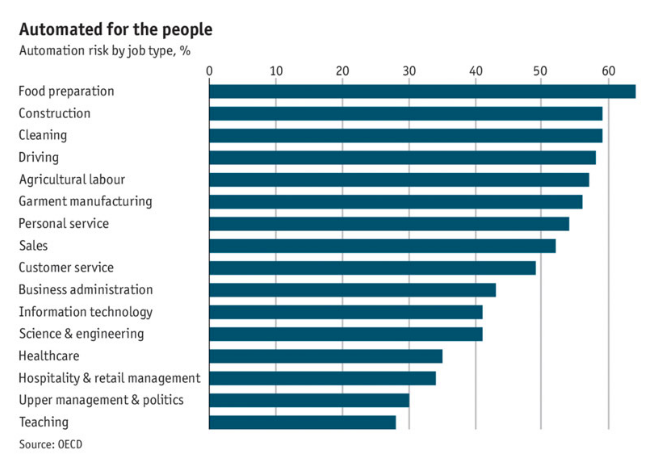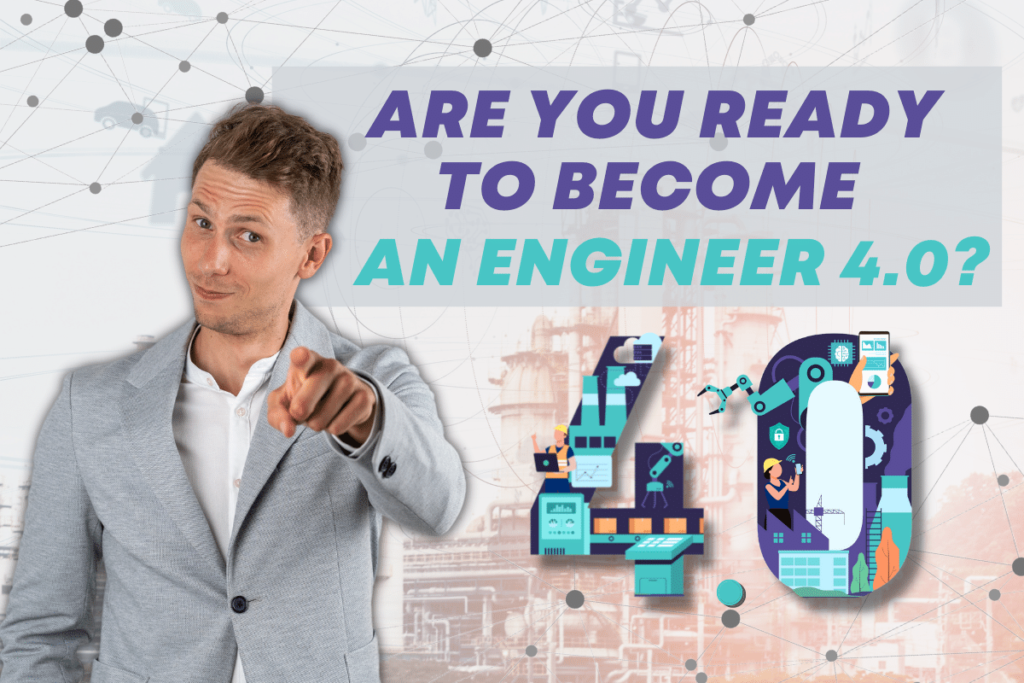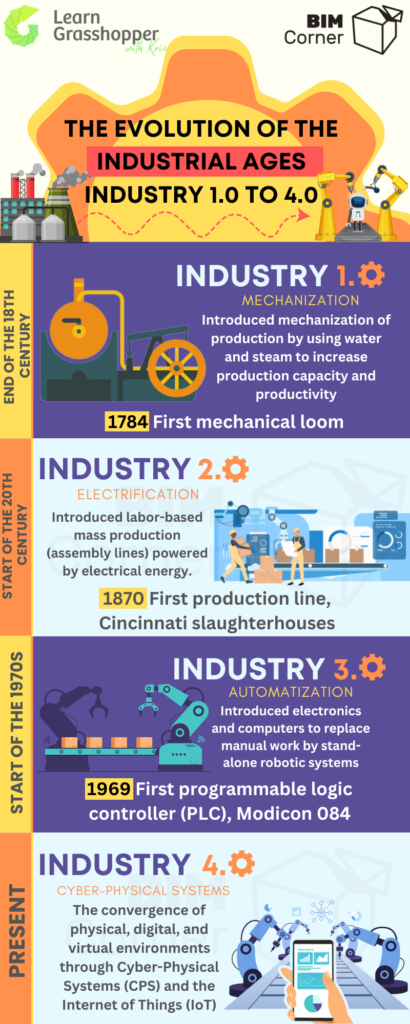Table of Contents
1. Goal of Engineering
2. What constitutes an industrial revolution?
We could say that engineering has been in existence for as long as the world’s earliest inventions. That includes the wheel around 3500 BC and the building of the Step Pyramid at Saqqārah in Egypt, around 2550 BC.
Each of those steps – decomposition, pattern recognition, abstraction and algorithms are as important as the others. Together these form the layers of the foundation for programming. Remember that only by applying all of them together will you be able to achieve the results. Omitting any one of them will make your foundation weak.
3.0. The Industrial Revolutions
3.1. Engineering 1.0 – The Industrial Revolution (1780–1840)
In the 1776’s, James Watt improved the efficiency of an already existing steam engine. His work and development enabled the use of steam engines for industrial purposes. This was the most significant breakthrough for increasing human productivity. We can say that steam engines paved the way for the industrial revolution. Instead of producing threads on simple spinning wheels, the mechanised version achieved eight times the volume simultaneously.
Manual labour was slowly replaced by machines powered by steam engines, with the engineers who created these machines gaining widespread recognition for their skill and professionalism.
Inventions were designed and communicated to manufacturing using paper, vellum, mylar drawings, or blueprints. There was extensive use of physical prototypes and trial and error engineering.
3.2. Engineering 2.0 – The Technological Revolution (1870–1969)
The Second Industrial Revolution began in 1870 and was characterised by the discovery of gas and oil. These materials were used to create electricity and advanced powered technology. In addition, innovations in steel-making processes and new electrical grid systems in every city had a considerable influence.
However, Henry Ford had the most significant impact on the industry and how things were produced. He developed the assembly line for car production. Manufacturing grew in speed and scaled quickly through mass production and distribution systems.
The enormous expansion of rail and telegraph lines allowed unprecedented movement of people and ideas. In this period, research began to play a significant role in the field. Universities began to establish graduate programs for engineering students. All that culminated in a new wave of globalization.
3.3. Engineering 3.0 – The Computer era (1969 - 2015)
The Third Industrial Revolution began in the ’70s of the 20th century. The Moon landing, the beginning of nuclear energy and partial automation using computers, were game-changers. All these inventions were the beginning of the computer technology era, mainly used to increase productivity in production. Since introducing these technologies, engineers have been able to automate an entire production process without human assistance. Known examples of this are robots that perform programmed sequences without human intervention. Two previous industrial revolutions enabled large-scale production through mechanical aides. Thanks to programmable logic controllers (PLC) automated systems could now perform human tasks such as planning, scheduling, and tracking production flow.
Although automated systems were in place, they still relied on engineer input and intervention. Computational power and computerised drafting tools made it possible to design things faster.
3.4. Engineering 4.0 – (2015 – ?)
So, what’s next for Engineering?
“Industry 4.0” is a commonly used term to refer to the fourth industrial revolution that is now underway. The trademark of this transformation is the effect of various digital technologies such as the Internet of Things, Robotics, Cloud Computing, Additive Manufacturing, computational workflows, Machine Learning and others.
These technological changes are likely to be bigger, better, and bolder than any revolution before. And the changes are going to happen at an exponential speed.
The fundamentals of Industry 4.0 are built on the developments of the Third Industrial Revolution. The key to this new revolution is how business owners will be enabled to make more informed decisions backed by data and analytics across all aspects of their operations.
Now we have work connections expanding existing Computer technology, and many production systems have its digital twin. This digital copy of the world is interactive and runs in parallel with human development. This brings us to the point where machines can autonomously predict failures and trigger maintenance processes or self-organize logistics that react to unexpected production/construction process changes. The main aim of all this is to reduce downtime and calculate predictions. The new approach allows the industry to run more smoothly and have a greater insight into the whole supply chain.
4.0. How will Industry 4.0 influence civil engineers?
It will no longer be common to expect each engineer to search around for necessary data. Shared data will always be available on the cloud. Access to the relevant people will be via the appropriate tool. Information will be distributed using an automated delivery and update mechanism by way of using automated tasks, integrated BIM Models, Optimization Simulation and Technical Communication tools.
Industry 4.0 will also change the way we work.
Research says that 65% of children today will end up in careers that don’t even exist yet. So the education system needs to prepare them for this new world. It must give people the necessary skills to adapt. But what are these future skills? The World Economic Forum asked executives from some of the world’s leading companies what they thought the essential job skills would be in future. [1]
The most frequent answers were complex problem-solving and critical thinking, and innovative approaches to as-yet unknown puzzles. Learning computational thinking and programming will be crucial for further development.
Despite all the optimism that comes with the future, there are good reasons to be concerned as well. The Economist predicts that 50% of jobs will be vulnerable to automation in the near future [2]. However, some industries are more likely to be automated than others. As you can see in the graph below, the construction industry is at the top of the graph, with almost 60% risk. However, this doesn’t mean that 60% of people will lose their job. Some people will have to retrain in order to stay in the market and follow trends in the industry.

The jobs are here, but where are the people?
While automation might be a threat in the future, a present issue is the shortage of qualified engineers. This is a global problem. Universities have caps on how many engineers will leave schools with degrees, but this is far less than the industry demands. The changes in all industries are coming so quickly that a so-called skills gap is being created already.
Of 3.5 million job openings in manufacturing over the next decade, there’ll only be enough skilled labour to fill less than half of them.
Education First, Then the Industry 4.0
Ensuring a successful transition into Industry 4.0 across the world will require a supply of highly skilled consultants and employees to change the standard way of working. A crucial part of this lies in ensuring that you continuously develop your professional skills. This includes technical skills, learning new technologies, and enhancing your current level of knowledge. In addition, you should work to improve your soft skills as employers value these, and they will help you steer through an uncertain future.
It’s also essential to have an open mind about your engineering discipline. This is because future engineering firms will require people with a broad range of skills rather than those specialising in a particular mechanical or electrical engineering discipline. You might need both validation skills and the ability to write code, for example. [3]
5.0. Summary
Check out my other articles about Grasshopper
BIM in Grasshopper – The ultimate software list
Grasshopper Data Tree – Path Mapper is a BADASS
If you want to get more information about Grasshopper and learn parametric modelling, download the free guide – FREE DOWNLOAD
Grasshopper is a plugin to Rhino that you can download HERE
Bibliography:
https://www.desouttertools.com/industry-4-0/news/503/industrial-revolution-from-industry-1-0-to-industry-4-0
https://www.weforum.org/agenda/2016/01/the-fourth-industrial-revolution-what-it-means-and-how-to-respond/













